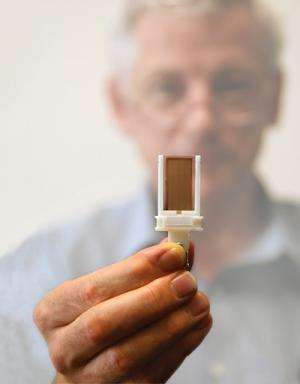Liquid crystal sensing badges monitor hazard exposure

In 1999, researchers in New York City identified the first case of West Nile virus, which over the next five years spread across the country. Infected mosquitoes transmit the virus into reptiles, amphibians, and some mammals—including humans—and into more than 100 species of birds, which "host" the virus.
At the time, identifying the disease in dead birds was cumbersome and time-consuming because existing tools required a different diagnostic reagent to detect antibodies in each species. "We developed a way to use liquid crystal to report antibodies to West Nile virus in a way that was species-agnostic," says John T. and Magdalen L. Sobota Professor of Chemical and Biological Engineering Nicholas Abbott, who with Christopher Murphy and Barbara Israel (then both faculty in the School of Veterinary Medicine), co-founded Platypus Technologies in 2000 to commercialize the technology.
Liquid crystals, which are materials that combine properties of solids and liquid, are known to change their ordering and optical appearance in response to stimuli such as temperature or electrical fields. As a result, they are useful in everything from cell phone displays to environmental sensors.
Over the past 13 years, the Platypus founders have developed a variety of liquid crystal-based technologies for protein and cell-based studies and environmental monitoring. In August 2013, the company debuted a wearable sensing badge that allows, for example, workers in an oil refinery to accurately monitor their exposure to hydrogen sulfide in real time. The U.S. Occupational Safety and Health Administration regulates worker exposure to the chemical, which is a highly toxic, flammable gas—and currently, hydrogen sulfide samples gathered in the workplace are analyzed days later in a laboratory.
The badge is somewhat like a detector worn by radiological workers. "A worker can read it at the end of a shift," says Abbott.
Provided by University of Wisconsin-Madison

















